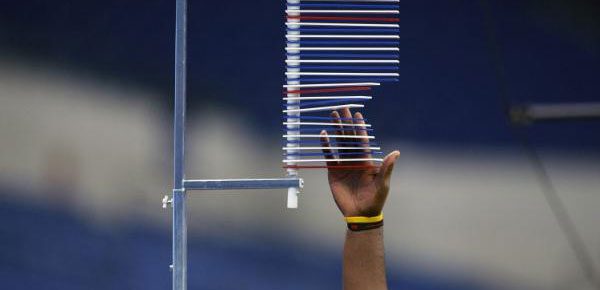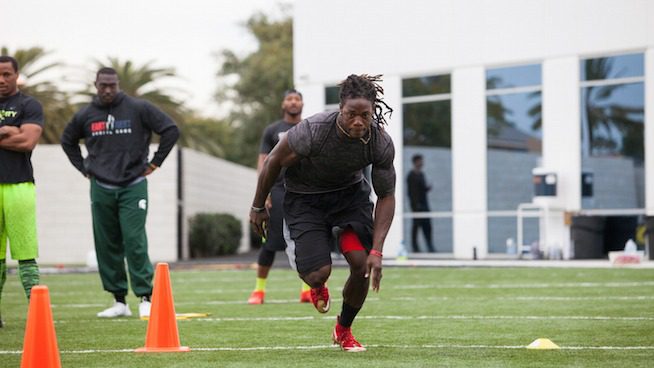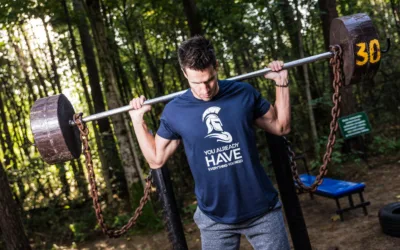4 Scientifically Proven Ways To Develop Explosive Power (And How To Program Each)
Building athletic power is one of the most desired, if not the most desired, quality in athletic performance today. The question is…how do we optimally train it?
Getting athletes stronger is not terribly difficult. Moving a barbell from point A to point B is the result of many factors: better technique, improved coordination of the lift, thicker tendons, etc. Improving any of these factors helps an athlete move a bar from A to B (and gives the coach some credit to brag to peers).
What about power though? Well, you get what you train for.

Written By
Joel Smith
Joel Smith, MS, CSCS is a NCAA Division I Strength Coach working in the PAC12 conference. He has been a track and field jumper and javelin thrower, track coach, strength coach, personal trainer, researcher, writer and lecturer in his 8 years in the professional field. You can connect with Joel on his website.
Website
What Exactly Is Power?
Power is the ability to recruit a lot of motor units (or at least a large percentage of available motor units) into movement, and do so rapidly.
Power output is important for sport success. Research has shown power outputs are strong determinants of what level athletes will compete in. Getting an athlete more powerful gets their foot in the door to compete at a higher level.
Looking at how powerful an athlete is, or what we might simply call “horsepower,” is not clearly defined by research. We do know that the standby assessment of power (the vertical jump) is actually shown not to be as valid as we might think (although there certainly is some good validity) as various body/muscle-tendon characteristics and even the structure and strength of an athlete’s feet are major players in how high one jumps.


I’ve had athletes that were a full 6-8 inches ahead of their peers in their vertical jump, but were not significantly more “powerful” (they were sometimes even weaker in other measures such as power clean to bodyweight ratio).
What would I say is a true mark of power in an athlete? I think it’s specific to the sport, largely. Looking at power for sports, you could say: how well can you produce rapid force in relevant movements of your game?
If you are looking at more “general” displays of power, a spectrum of measurement means is appropriate to allow various anthropometric characteristics to be filtered out.
For example, take a look at a vertical jump versus a backwards medicine ball throw for distance. Long legs are good for jumping, while a longer torso offers better mechanical advantage for heaving things. I work with a long-torsoed, floppy-ankled Olympic champion swimmer who has only a “modest” standing vertical, but can throw a 40lb medicine ball a good deal higher than the most powerful track and field thrower on campus. His vertical jump does him no justice in describing his power output ability.
That said, here are some good “general” measures of power that all together offer a good idea of an athlete’s power potential.


- 10-, 20-, and 40-yard dashes (raw horsepower is more correlated to the first 10-20 meters, while technique and elasticity become more important at 40 yards and beyond)
- Vertical jump
- Standing long jump (another measure of vertical power with a slightly greater emphasis on upper body and torso hinging ability. Track and field throwers are classically better at this compared to their standing vertical jump due to greater upper body strength and power)
- Maximal medicine ball or shot put throws for distance (which would display coordinative and sequential power)
- Olympic lifting outputs in well-trained athletes (poorly-trained athletes in the Olympic disciplines will not be able to harness their power here, and are better assessed or trained through heavy medicine ball throw measurements)
How Do We Best Improve This Power?
If a particular level of sport (high school vs. college vs. pro) is strongly influenced by power output, then we should know how to optimally train it – not only in the short-term, but also for the long haul! Generally speaking, there can be benefits from each of the following:
1. Resistance training: According to a research analysis by Chris Beardsley, higher repetition lifting speed training is more advantageous than lifting with lower repetition speeds for the sake of power development.
2. Ballistic resistance training: Ballistic resistance training is the act of performing traditional resistance training movements, such as squats and bench presses, at high velocity, and often shortened ranges of motion.
3. Olympic weightlifting: There is a lot of similarity between Olympic weightlifting and ballistic lifting, although Olympic lifting seems to cover a broader spectrum of the power-to-speed spectrum.
4. Plyometrics: Plyometric training, in a broad definition, is a jumping exercise that puts a premium on force absorption and release.
Remember the answer to how well a method works with a given population should always have context. Knowing that an exercise “works” for getting powerful is just the starting point.
As athletes increase in ability level and training age, what “works” narrows and decision-making on which movements to use becomes more selective. The 100m Olympic champion is not using a tremendous amount of exercises outside of sprinting. That guy on YouTube who could get his nose over the rim to dunk isn’t doing a whole lot of training outside of playing basketball and dunking.
Very high-level athletes can get away with this, while lower and moderate-level athletes must utilize a greater spectrum of strength and special strength methods to force their nervous systems to higher outputs.
Where heavy strength training may help an athlete increase their specific power in early training years, it may not have good transfer later on.
Just remember the most dangerous words in physical preparation are: “We’ve always done it this way.” So here are four other methods to try…
Resistance Training
This is simple enough: you get what you train for.
- Motor-learning expert Frans Bosch has made the statement that regular training against heavy loads will decrease rate of force production.
- On the other hand, we also know there are a good amount of case studies from reputable track and field coaches showing that elite athletes routinely lift heavy loads in squats or Olympic movements days, or even hours before a major competition, and the result being a gold medal.
So what gives? Research says lift fast for rate of force development, but practice shows that, in advanced and strong athletes, heavy lifting can boost performance to its highest levels.
My takeaway of the matter is this: In terms of long-term training adaptation, regularly moving fast will train us to be fast. Even those athletes who lifted very heavy prior to a gold medal trained fast the vast majority of the time.
Heavy lifting is a nitrous-oxide-like training dose that will boost an athlete’s nervous system to optimize what they already have … or in other words, it helps with potentiation. Using heavy lifting as a means to achieving power, absent of the proper speed-building channels, is a sport performance nightmare on the short- and long-term level.
Realize, however, that not every athlete harnesses potentiation the same way. Some athletes will not gain increased neural drive that can be wired into their sport, while others will.
When it comes to dosages, results will always be split because not every athlete responds the same! Some athletes respond well to low volume/high intensity, while others require moderate to high volumes and low to medium intensities, etc.
In terms of heavy resistance training, and optimal time of the year to apply this work, we can only infer from the effects of the practice. Since we know heavy strength training offers a benefit from a perspective of motor recruitment, it would make sense to utilize this work to increase the availability of the motor pool prior to phases of training with a greater power emphasis.
The problem with using heavy-weight training, however, is that over time it “stiffens” the nervous system, which decreases motor learning, coordination, and fast rate of force development. Some coaches, such as Nelio Moura have written that this occurs after 7 weeks of sustained maximal strength work.
The tried and true method of having a period of heavy lifting, say 2×3 week blocks followed up by a few months of plyometric emphasized work, is generally a great strategy.
Programming Ideas in Heavy Resistance Training
- Slow Cook the Process: For the sake of athletic power, with heavy resistance training, or resistance training in general, it is important to not do “as much as you can get away with”, but rather, the minimal amount necessary to make a change in performance. Too much work too early in a career or season (even if it’s met with quick results) can stiffen the nervous system and negatively impact adaptation.
- Heavy Strength and Low Reps for Fast Twitch Types: Just because you take a look at the programming of the fastest and strongest professional athletes doesn’t mean it will work for you. Slow and moderate twitch athletes can get easily overloaded by low rep, powerlifting style work. For fast-twitch and neurally “wired” athletes, lower rep training means under 5 reps, and training loads over 80% of one’s maximal ability will be highly stimulating to this population.
- Higher Rep and Single Set, or Higher Frequency Lower Volume Models for Moderate and Slower Twitch: I’ve found “slower twitch” athletes who I lumped in with all the fast twitch athletes in training groups would struggle to make solid gains, until I switched them to single set, higher rep training, such as 1×15 or 1×20. To make optimal gains, you must optimally stimulate your spectrum of muscle fibers.
Ballistic Resistance Training
Common exercises here are the jump squat or trap bar deadlift jumps. These training means are easier to apply than the Olympic lifts because they require almost zero technical training – which makes them particularly useful for training athletes without Olympic experience in the short-term!
Research has shown ballistic work to be superior to traditional, slower resistance training for the sake of vertical jump improvement, particularly in trained athletes. For example, ballistic squat jump training significantly improved vertical jumps in elite volleyball players and was more effective than standard slower lifting.
One study showed the simple act of adding a velocity-monitoring unit to one exercise in an entire training program, the jump squat, allowed for significant improvements in measures of power vs. those who followed the exact same program, but did not monitor the jump squat externally. Standing long jumps and the 30m dash were particularly effective at ramping up the jump squat. Vertical jump and 10-20 meter sprints were less effective.
Programming ideas in Ballistic resistance training
Ballistic Training has the Highest Specificity and is Very Sensitive to Bar Monitoring and Power Outputs: Adding overload with ballistic work, in terms of bar speed monitoring or timed sets can be an effective strategy here. An example of a timed set would be putting a barbell load equivalent to one’s bodyweight on the bar, and performing 5 to 8 half squats to a set bottom as fast as possible. When you perform jumps and plyometrics, chances are you measure jump velocity in some way, in the form of how high or far you jumped, so it should be the same with ballistics.
Olympic Weightlifting
Olympic weightlifting has been shown in research to improve both power and rate of force development. There is no surprise that it’s a common choice of track and field sprint and jump coaches alike.
It seems to be a prime choice for potentiation of big time power feats, such as the first 8-foot high jump (Javier Sotomayer did heavy snatch triples that morning), or Christian Taylor’s first place finish in the 2016 Olympic Trials in triple jump (hang cleaned 350lbs shortly before his competition).
Programming ideas for Olympic Weightlifting
- Higher Velocities are Top Priority: When Olympic lifting, fast bar speeds often come with the territory, but not always, particularly in an environment where lifting the maximal amount of weight is the highest priority, and there aren’t pro-level Olympic lifters to mirror. Whether you have barbell monitoring capabilities or not, a primary objective is to move the bar fast enough to keep the hips moving in speeds that are a similar ballpark to vertical and horizontal jumps.
- Use Low Reps, but Vary in Terms of Density: In Olympic weightlifting for power and athletic performance, low reps are of the essence (although I did read in a Charles Poliquin book, the story of a strength coach of a national champion squat who liked doing sets of 30 cleans). Alternate the usage of low density sets, such as 8×2 (optionally supersetted with a powerful activity of a complementary hip hinge rhythm such as bounding or vertical medicine ball throws), with set rep schemes such as EMOM sets of 3 for 10 minutes.
- Use Olympics to Optimize Athletic Rhythms: As I just mentioned, there are optimal rhythms in athletics. The Olympic lifts seem to have a great rhythm to complement a variety of athletic movements, and have value for many athletes performed prior to sprint, jump, plyometric or even swimming sessions.
Plyometrics
This would include depth jumps, hurdle hops, bounding, lateral bounds, and depth jumps, as well as combination movements like a two-leg broad jump to a single leg landing.
There are a great number of studies validating plyometrics as an effective training modality. One found plyometrics tend to provide their greatest effect in 10 weeks or less (perhaps the neural gains get “tapped out” after this). And when it comes to improving sprint speed…horizontal plyometrics were most effective (once again: you get what you train for).
Also, there is no benefit to adding weight to plyometrics; bodyweight is enough to make great use of this training!
In terms of plyometrics in the yearly training load, there are no hard rules. But my best advice would be to find 2-3 solid blocks of 4-8 weeks where you make good use of these exercises in their intense format.
Since plyometrics are a very high neural recruitment modality, they recruit fast-twitch fibers and have the capability of enhancing weight room lifts, in addition to improving jump measures.
Some forward-thinking coaches utilize plyometrics that combine multiple movements, (example: rotary movements linked into jumps) which can enhance transfer and specificity in how athletes actually move on the court.
In terms of yearly training, plyometrics and the amount of jumps seen in a team sport will have an inverse relationship. A basketball player who is practicing hard and taking a lot of jumps will not want to do the plyometric training volume they might perform in an offseason period of training. In periods of more frequent practice, low quantity, but intense plyometrics are often the best recipe.
Plyometrics can even go into the “overspeed realm” (as can sprinting), where athletes are hooked up to bands suspended from the ceiling, or positioned on a sliding cart, where they push off of a wall or surface at supramaximal speeds. This type of work is solid gold for athletes who are already strong, but need specific speed, and goes a step beyond traditional plyometrics in accomplishing higher jumps and increased rate of force development.
Plyometric Programming Ideas
- There is Still a Spectrum of Training Effects as per Contact Time: All plyometrics are not created the same. A sprint stride is fundamentally different than a vertical jump, as the rate of work is 5 times faster in a sprint stride. Utilize quick rate plyometrics, such as rapid line hops and barrier jumps, as well as slower rate work, such as depth jumps from a higher box. There is an art form of selecting the proper means for each athlete.
- Start with the Minimal Dose: Just because you can drop from that higher box doesn’t mean it’s a good idea. Start with the lowest volumes and intensities of plyometric work to make an impact on performance. Using plyometrics in excessive volume can cause an adverse adaptation pattern in later stages of training.
- Progress Over Time with Ability and Need: A good starting point in plyometric volumes is in the 40-75 contact realm for the high velocity work, such as low barrier hops, and 5-20 contact realm for lower velocity plyometrics. An example of this would be 3×10 low barrier hops and 3×10 speed tuck jumps, finishing with 3×5 depth jumps from an 18 inch box. Progressing this type of volume and intensity slowly over time is a key to success.
Where do we go from here?
The question then is: where do we go from here? A generally good idea is to either:
1. Throw the spectrum of means (from heavy lifting to plyometrics) at an athlete in a manner that allows you to note the changes, and then see what sticks. Find the individual preferences and best training practice for each athlete.
2. Utilize some of the technology out there that allows for assessment and training of athletes with either a force or velocity based jump or sprint profile to optimize the direction of power development.
Find Your Perfect Training Plan
Sometimes all you need to reach your destination on your fitness journey is an expert guide. Look no further, we've got you covered. Browse from thousands of programs for any goal and every type of athlete.
Try any programming subscription FREE for 7 days!
Related Articles
You May Also Like...
Slow Reps vs. Fast Reps
You’ve probably noticed that some people in the gym tend to perform their reps as fast as possible, whereas others take a slow and controlled approach. But which is better? Dr. Andy Galpin is a Professor of Kinesiology at the Center for Sport Performance at California...
How to Do Leg Extensions Without a Machine
Short shorts are the new stinger tanks. Rocking those big tree trunks with canyon deep cuts is so hot. Leg extensions are a bodybuilding staple—they isolate your quads, the front-facing muscle group of your thighs, by flexing (bending) and extending (straightening)...
Tried-and-True Methods to Fix Plantar Fasciitis
What is Plantar Fasciitis? If you’re new to running or returning to it after a break, you might have been blighted by plantar fasciitis, a fancy name for an annoyingly common foot problem. It’s when the band of tissue that connects your heel to your toes (the plantar...
Slow Reps vs. Fast Reps
You’ve probably noticed that some people in the gym tend to perform their reps as fast as possible, whereas others take a slow and controlled approach. But which is better? Dr. Andy Galpin is a Professor of Kinesiology at the Center for Sport Performance at California...
How to Do Leg Extensions Without a Machine
Short shorts are the new stinger tanks. Rocking those big tree trunks with canyon deep cuts is so hot. Leg extensions are a bodybuilding staple—they isolate your quads, the front-facing muscle group of your thighs, by flexing (bending) and extending (straightening)...


Want more training content?
Subscribe
For Coaches
For Athletes
About
Support
Training Lab
Access the latest articles, reviews, and case studies from the top strength and conditioning minds in the TH Training Lab!
Made with love, sweat, protein isolate and hard work in Denver, CO
© 2024 TrainHeroic, Inc. All rights reserved.





